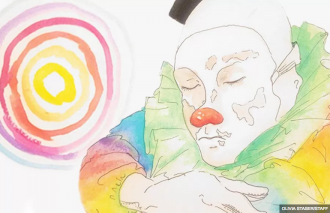This summer, the Berkeley Art Museum and Pacific Film Archive is featuring three distinct visual art exhibits — works from contemporary mixed-media artist Ugo Rondinone, early surrealist Charles Howard and a collection of five centuries of Indian painting. The galleries highlight art that has both been historically overlooked and won’t let you look away.
The central gallery space belongs to Rondinone’s absorbing exhibit “the world just makes me laugh,” running through August 27. The largest room is dotted by the exhibition’s commanding centerpiece, titled “vocabulary of solitude.” 45 bright, seemingly sedated but lifelike clowns lounge, unconcerned and incremental. The realism is compounded by the fact that each clown was molded off a real person.
According to Rondinone, the clowns collectively “represent one person in solitary activity within an enclosed space.” He wrote of the piece that “each single clown is named in the present tense after one solitary activity: Be. Breathe. Sleep. Dream. Wake. Rise. Sit. Hear. Look. Think. Stand. Walk. Pee. Shower. Dress. Drink. Fart. Shit. Read. Laugh. Cook. Smell. Taste. Eat. Clean. Write. Daydream. Remember. Cry. Nap. Wank. Feel. Moan. Enjoy Float. Love. Hope. Wish. Sing. Dance. Fall. Curse. Yawn. Undress. Lie.” A day in the life.
The clowns appear to rest, eyes shut and faces expressionless, across the floor. Lying down and leaning against walls in convincingly realistic poses, the exhibit’s troop of spangled subjects is guaranteed to mesmerize visitors — and possibly traumatize the night guard.
Walking among the clowns, it’s hard to identify the resulting sensation. A neon, light-hearted color pallette surrounds you, but the piece is eerily still, drawing out a conflicting feeling. The clown as a character of art has had many interpretations. While the cinematic horror genre has most recognizably turned their intent upside down, Rondinone’s work offers a far less simplistic viewpoint on the misunderstood jester.
The immense scale and consistent color scheme of the piece suggests uniformity, but upon a tentatively closer look, each clown’s costuming and expressions are, in fact, individual. Though visually forceful at first, approaching the clowns up close reveals their humanity and shakes this off-kilter notion. It is replaced by a slight, sparkling melancholy.
Rondinone’s exhibit continues into smaller rooms; one space features a wall of rainbows, each hand-drawn by Berkeley schoolchildren. Another room similarly features an overwhelming amount of visual information, but this time in subdued, disarming hues of black and white. Lining the shaded walls are framed ink drawings closely neighboring one another, making up Rondinone’s 60-drawing series “1998 diary.”
The diary’s words are claustrophobic and thought-provoking, and their visual construction reflects the pressing tone. Block letters are caved in by black ink, forcing the outlines to frame and construct each word; in contrast to a traditional script, which leaves the border open, here each diary entry burrows in.
“Everywhere around me there’s the restless sound of people murmuring that flows like a river from room to room, while we’re all lying on our beds trying not to think about our opportunities,” reads one the entries.
Rondinone’s work, though a product of mixed media, takes inspiration from the romantic and surrealist art movements. And just a floor below Rondinone’s exhibit, BAMPFA is simultaneously hosting a collection of works by a pioneer of surrealism, Berkeley native Charles Howard.
Howard, who lived from 1899 to 1978, created a wealth of warm, intimate, architectural yet surreal works throughout the mid-century period. During this time, he showed work with many of the recognizable artists of the era such as Salvador Dalí, Man Ray and Alexander Calder. Though comparable in skill and approach to his surrealist contemporaries, Howard has remained relatively unknown outside the art world.
Born into the “first family of Bay Area modernism” — his father John Galen Howard was the supervising architect of UC Berkeley — the younger Howard did not initially gravitate toward the arts. In fact, he attended UC Berkeley with the intention of becoming a journalist, but after a trip to Italy, was moved to try his hand at the family business.
The exhibit displays the trajectory of Howard’s career, with works from each decade he created in, including several ink-on-paper drawings that demonstrate the bones of Howard’s characteristically steady harmonic style.
This comprehensive presentation of Howard’s pieces demonstrates the cohesiveness between his works. He once said all his pieces were of the same subject matter. What that subject is, however, is up to the individual.
Curator Apsara DiQuinzio described Howard’s work as “a synthesis of oppositional forces” and characterized BAMPFA’s exhibit, titled “Charles Howard: A Margin of Chaos,” as an attempt to bring his work “back into historical focus.”
The last visual art exhibit showing at BAMPFA similarly strives to showcase art forgotten by time. “Divine Visions, Earthly Pleasures: Five Hundred Years of Indian Painting” includes more than 60 works grouped in thematic categories such as religious painting, portraiture and paintings associated with music.
The collection is comprehensive, covering everything from early-15th-century paintings all the way up to modern times. Such an expansive sampling demonstrates that strong and expressive line is a consistent theme throughout.
The three exhibits sharing BAMPFA this summer, though pronounced in time and form, reveal surrealist undertones that defy being painted in broad strokes.
Audrey McNamara is the executive news editor. Contact her at amcnamara@dailycal.org.
